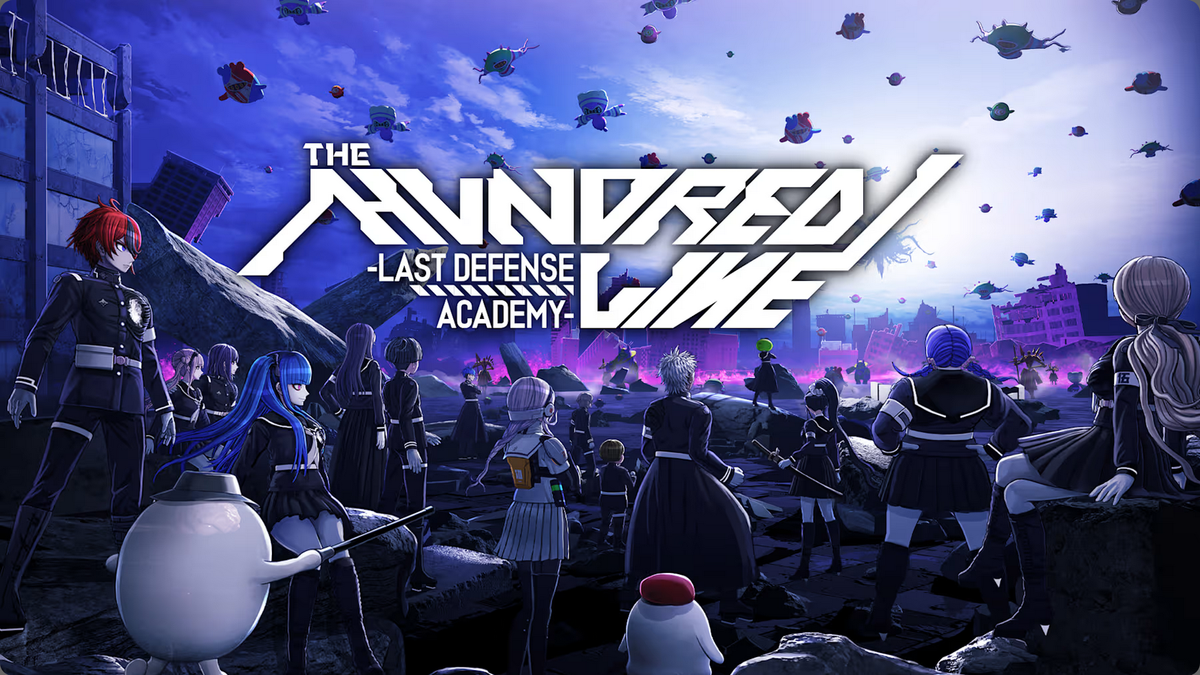
Kotaro Uchikoshi and Kazutaka Kodaka. For visual novel fans, these two names need no introduction. The former created the Zero Escape and AI: The Somnium Files series; the latter being the mastermind behind the iconic Danganronpa and the recent Rain Code. Without trying to sound hyperbolic, the works of these two prolific VN writers have shaped my tastes and interests to be what they are today. Uchikoshi’s 999 was my first introduction to the niche genre of visual novels, with a story that made me feel awestruck in how it pushed the boundaries of what video games can accomplish as a storytelling medium. As for Kodaka, the powerful message of Danganronpa v3 resonated with me so much that it pushed me to take a leap of faith to pursue games media.
As a result, when Uchikoshi and Kodaka publicly announced in 2018 that they formed the studio Too Kyo Games, the thought of knowing they would team up to make a game together felt surreal for me. While they collaborated for the release of World's End Club in 2021, the initial project they teased in 2018 titled Limit x Despair remained shrouded in mystery. Over six years and a name change later, the fruits of their labor have come to fruition with The Hundred Line -Last Defense Academy-.
Hundred Line centers around protagonist Takumi Sumino, an ordinary high schooler living an ordinary life in a town called the Tokyo Residential Complex. This all changes when monsters called School Invaders wreak havoc on the TRC. Amidst the chaos, Takumi encounters a Sirei, a strange mascot creature who whisks him and 14 other kids to the Last Defense academy, a school enshrouded by undying purple flames. The students are entrusted with the daunting task of defending the campus from invaders for 100 days to save humanity.
With this being a collaboration, I was intrigued in what the twisted minds of Kodaka and Uchikoshi could come up with, and how they would approach dividing the work amongst one another. According to a development blog from Uchikoshi, Kodaka was in charge of writing the main scenario and true ending, whereas Uchikoshi was responsible for leading a team of writers to execute one of the main selling points of the game: the branching routes leading to 99 alternate endings. Essentially this is primarily a Kodaka story presented via a non-linear framework standard in most Uchikoshi games. Thus, despite my excitement, I still maintained a healthy bit of skepticism. For context, I am mixed on most of Kodaka’s other works outside of the third Danganronpa game. His most recent game, Rain Code, is one I heavily dislike.
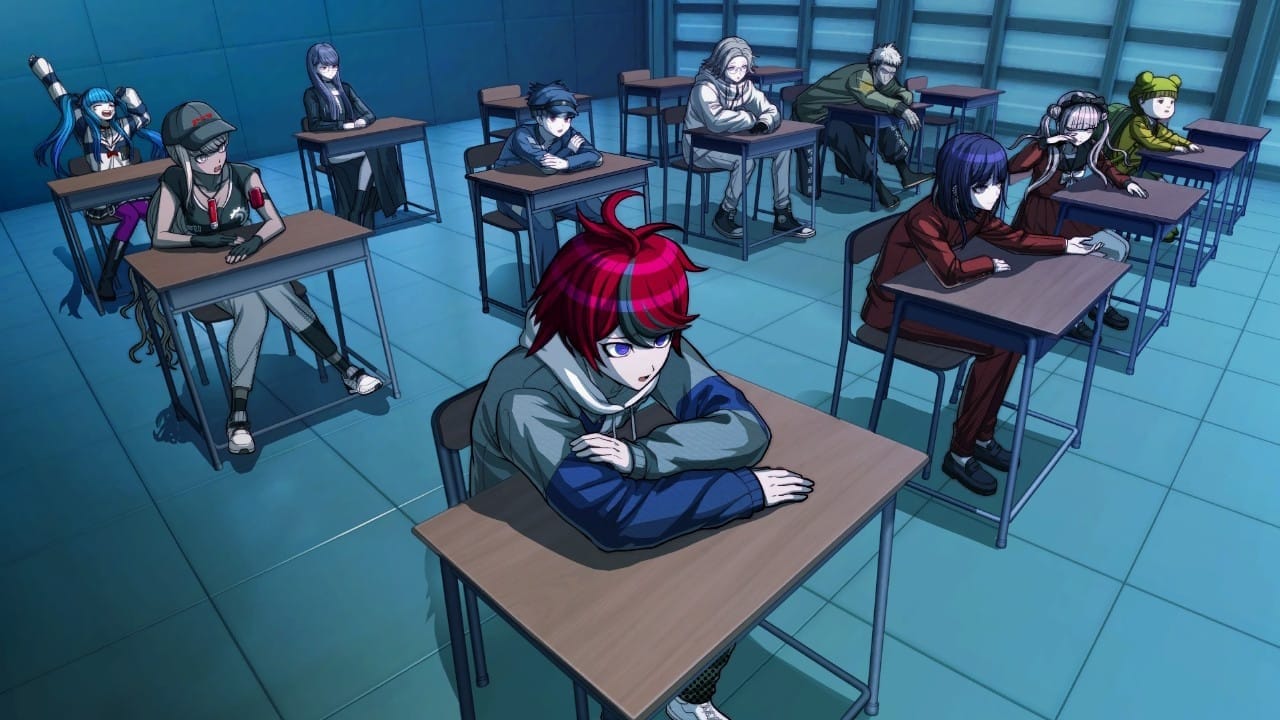
After spending 80 hours unlocking the true end as well as 40 other endings, I can echo how Hundred Line's character writing and true route feels more Kodaka than Uchikoshi. Heck, the premise of 15 students being trapped in a school by a mascot character is ripped straight out of Danganronpa, with the same imagery and everything. So, as someone who isn’t a fan of most of Kodaka’s games, what did I think of the main story? Despite its many, and I mean many, glaring problems, I left loving the overall adventure.
One of the main caveats of my adoration for the story is its beefy runtime. It took me around 60 hours to reach the true ending as well as clearing 10 of the 100 total endings, and this is on top of me being a speed reader when it comes to unvoiced dialogue. Approximately 25-30 hours of this playtime felt like an endurance test. The narrative is very much a slow burn, one that is stretched way too thin. My fears regarding the premise being how the students need to defend the school for 100 days unfortunately came to fruition, with plenty of days glacially spent in the Free Time sections with very little plot or character development.

A major factor that makes the first half a slog is how the mystery evolves within these 30 hours. The story sets up plenty of questions early in regards to the nature of the Invaders, and the role the students and the Last Defense Academy play within the overall conflict. But each time more information is about to be uncovered, the game repeatedly spams random plot reasons to avoid uncovering the details of the mystery. A few times would be fine for building anticipation, but it happens ad nauseam.
With that being said, there is superb payoff once the slow burn is completed, fundamentally shifting the foundations of the plot into the promised branching narrative Uchikoshi fans are familiar with. The story picks up immensely, and rarely lets up with how well the mystery is handled. While there is still not much that happens in the overall plot, it is kept engaging by having answers consistently rolling in regarding the many mysteries. Every reveal births more questions and contradictions to previously established truths. Takumi blossoms into a fantastic protagonist that serves as a vessel to present the game’s stance on how destructive war is, robbing children born into an era of violence of their youthful innocence. No matter what choices you have Takumi make, what route you have him go down through these 100 days, this remains a consistent thematic throughline. Still, asking the player to dedicate 30 hours, the length of entire other games, to finally reach these highs is a big ask.

Regrettably, there is one issue that still infects the game even when it does pick up. Without sugarcoating it, the dialogue writing is shockingly atrocious. Danganronpa and Rain Code are no stranger to having characters with one prominent trait about them. Both of their premises actively weaves this into their character building by tying their personalities with their professions and skill sets, often to mixed results. But even these titles show restraint by not having most of the cast spout out their main trait almost every single line. While I am glad the lack of a death game structure means giving the entire cast a moment or two to shine, the distracting writing severely dampens the impact of both character development, and the overall narrative.

Initially I was bummed about the lack of original twists in this title, especially for two writers synonymous with their bonkers twists. Without spoiling specifics, a good chunk of revelations in Hundred Line mirrors past plot beats and themes in previous Uchikoshi and Kodaka games. However as I stewed on it a bit more, it felt like a culmination of these two writer’s works. A celebration of their thematic philosophies as they pave towards a new future.
The problem lies in how these twists are presented through the text. The way characters react to shocking reveals is just shy of the game winking at the player and blatantly saying it's a reference. Even though these twists make sense within the context of the plot, and are telegraphed fine enough to where I was able to predict most of them, they consequently feel slightly derivative to the past with how they are written.

As for the students of Last Defense Academy, characters such as Shoma go through a touching arc about growing past his self depreciation, or Darumi who constantly alludes to a rough upbringing by making references to games and media as escapism. However, almost every line of dialogue uttered by these characters blatantly expresses these traits through the text, rather than relying on subtext. People who feel like caricatures, instead of characters. Personalities attached to a person, rather than a person with a personality. For a story with such a strong message about the nature of humanity, it is a shame that most of the cast don’t speak like humans. There are a few exceptions of course, but this, alongside minimal and rushed development for the cast in the main story, makes this one of my least favorite Kodaka groups when examining each character individually.
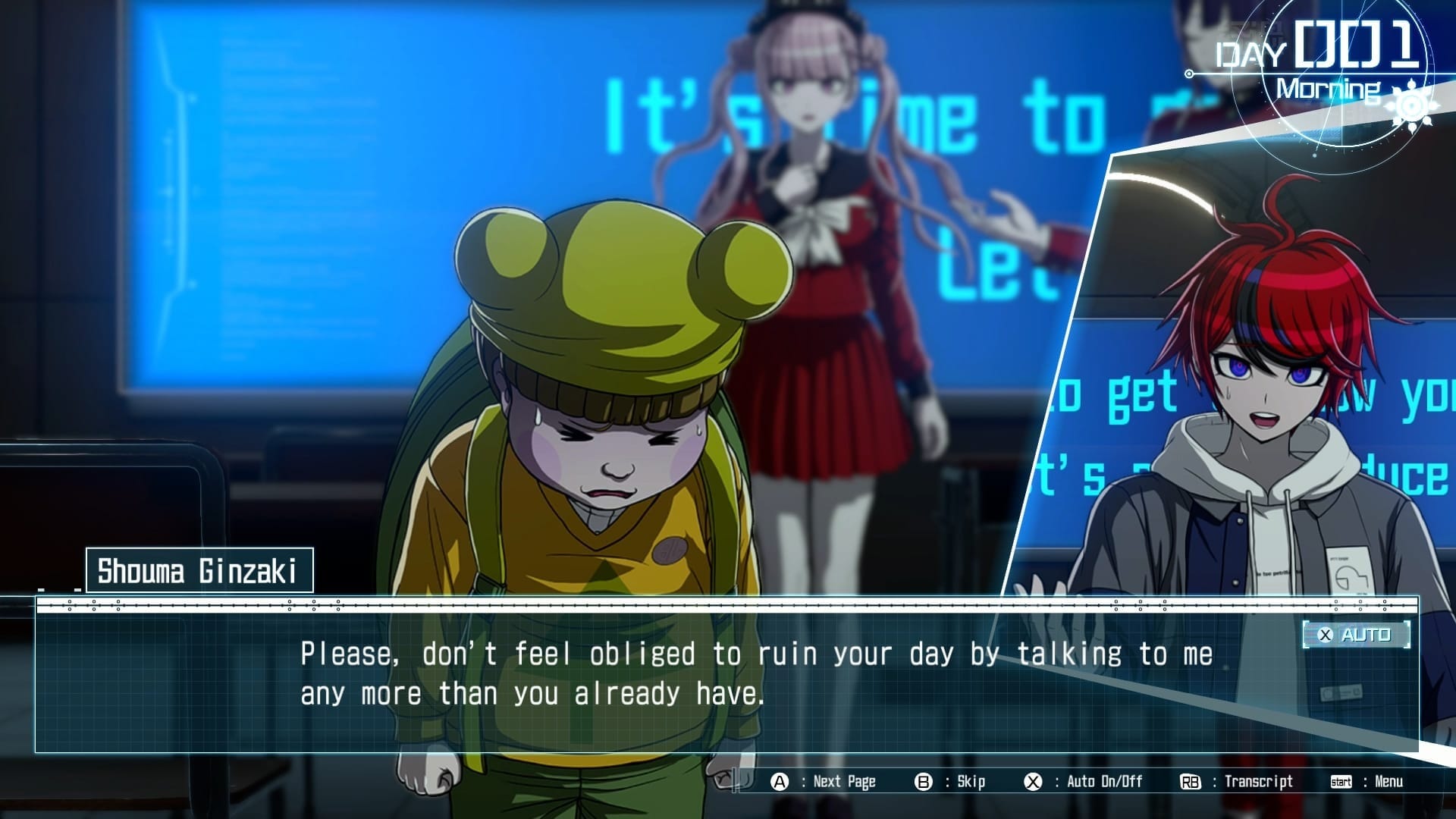
And that word “individually” is an important distinction when talking about my thoughts on the characters. Because as an ensemble, this cast excels as an entity for Takumi to play off of depending where he currently is in his arc, and at hammering home one of the game’s central themes about the innocence of youth. The importance of letting kids be kids.
Each character has their unique quirks and problems for sure, but their sheltered life at the TRC essentially makes most of them empty canvases in terms of broader life experiences. Hence, there is a mix of fear and joyful wonder when these kids discover the world outside the complex for the first time; experiencing activities they could only dream about beforehand. Their laughter and tears color in that blank canvas. Sure, it can feel heavily ham-fisted sometimes, and once again the writing does it no favors, but this joy and jubilation emanating from a cooperative cast was refreshingly unexpected as the driving force for a Kodaka story.

Don't get me wrong, each of Kodaka’s games has an uplifting and optimistic message engraved in their core theses, but they often had to bloom after being buried in the cynicism of each title’s premise and world building. What the characters have to rise up to protect. Hundred Line arguably has the most misanthropic world out of all of them with the contentious subject matter it boldly handles. It is not shy utilizing its invaders versus invaded conflict to critique war and colonization. How people are doomed to repeat the same mistakes, killing the future of those born in the midst of a hateful world.
The initial focus is less so observing how the characters overcome that cynicism, but rather observing how they live in isolation of that cynicism. What life could be like without war and hate. The mystery takes a backseat to observing these lost souls bickering with each other over their situation, their coldness towards each other eventually melting into a cooperation and friendship. Each group bonding event they perform strengthens their humanity further; a serenity in stark contrast to the death and destruction they have been forced to face when discarding their humanity on the battlefield. And it is that isolation between these two aspects that Kodaka justifies having yet another cast of teens.

JRPGs are no stranger to having a party of high schoolers battling monsters to save the world. In Danganronpa’s case, it has a group of high schoolers being forced to partake in a death game. Yet, more than any of Kodaka’s previous works, Hundred Line uses its story premise and world building to justify this choice. The game does not shy away at hammering home how screwed up forcing children to become soldiers is. How the minds of the youth are malleable by authority figures; the dangers of living in a metaphorical echo chamber of the TRC that slowly phases out literature and media. And of course, the unsubtle critique of responding to invaders crossing the school’s walls with fear and violence. Substituting empathy with hatred. Every morning announcement repeats the same rhetoric to dehumanize the enemies the defense academy are tasked with killing.
What I adore is how the strategy RPG gameplay is actively utilized as a storytelling device to extrapolate on these themes. Most of the battles feel necessary to the story with the narrative developments they provide, having the characters grapple with the gray morality of the situation. Or at the very least offer a small character moment to demonstrate their growth. The topic isn’t exactly handled with subtle, or in depth nuance. But it wears its heart on its sleeve when presenting its optimistic message despite its bleak world and subject matter.
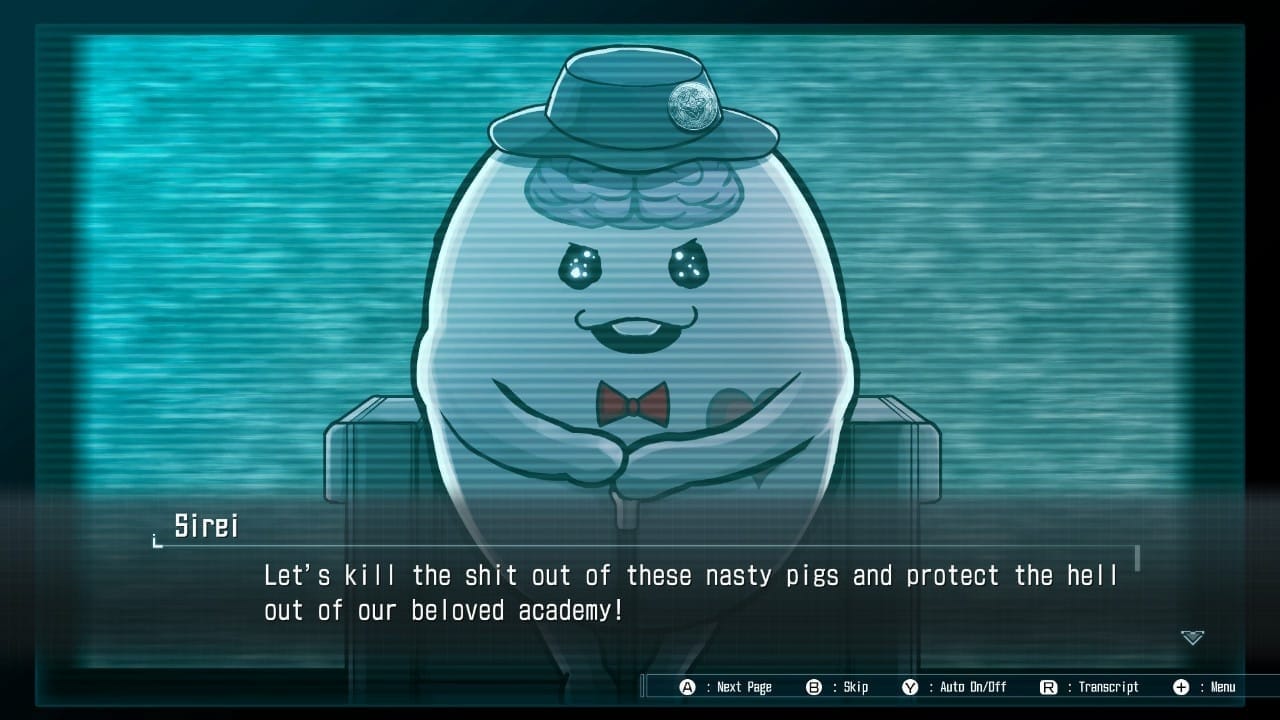
Speaking of battles, when I heard that Hundred Line would be a VN/strategy RPG hybrid, it instinctively filled me with caution. The inclusion of gameplay in visual novels typically feel like half baked, tacked on pace breakers. On top of that, I tend to find strategy RPGs difficult to get into, with my experience essentially boiling down to playing the recent Fire Emblem games on normal mode with the permadeath turned off, in addition to spamming the rewind turn function. Thus, I was pleasantly surprised how engaging Hundred Line's RPG systems were, beyond just being a strong narrative framing tool.
Too Kyo games collaborated with developer Media.Vision, known for classic RRG series such as Wild Arms and Valkyria Chronicles. Despite being veterans of the genre, Media.Vision has made a beginner friendly strategy RPG that serves as an excellent entry point for newcomers. The core of the battle system’s design is to take the mistakes made by beginners regarding the daunting aspects of the genre, and transform them into mechanics that give the battle system its depth. It rides a fine line between approachable simplicity, sprinkled with enough complexity for skill expression.

For starters, the consequence for party members dying is not only minimal thanks to them returning to the fray the next wave, but is actually encouraged as an offensive tool. Whenever a character is down to five HP or less, they get immediate access to their AOE ultimate skill called a Last Resort. These are normally accessed once the Voltage meter on the top of the screen reaches 100% or more. Not only does this method of sacrificing units not expend Voltage, but any character who dies in general will automatically add 100% to the meter. Performing most other actions will contribute to the meter, however characters dying is by far the most efficient. Voltage has other usage beyond activating ultimates. These include buffing a character’s attack for the remaining waves, being able to counter attack when hit by a foe, or boosting a character's movement while giving the party an extra Action Point (AP).
Speaking of AP, this is the glue that holds the entire battle system together. A number on the top left of the screen dictates how many actions the entire party can perform within a single turn. Whether it's attacking, defending, or dashing, any basic action performed by a unit will deplete the AP value by one. If a character has already used a point in a turn, they will enter a tired state, meaning they can only move a singular space whether dashing or attacking. This incentivizes utilizing other units on the field instead of constantly relying on your heavy hitters.

My favorite aspect of the Action Point system is the various methods of recovering AP. It is not necessary for every point to be consumed in a single turn, which means any points remaining once a turn has ended will be banked and carried over to the next. Taking out stronger enemies will recover one or more Action Points for the party depending on how many of them are killed in an attack. And of course there is the aforementioned Voltage skill that a unit can use to recover both their tired state, and give the party an extra AP.
This essentially addresses one of the more intimidating aspects in strategy RPGs for me. Recoverable Action Points offer more wiggle room in trying to efficiently maximize every decision on the battlefield. It minimizes the consequences of making a bad play by allowing the player to find opportunities to regain points, or wait till the next turn to have more actions to start with. For seasoned players, performing strategic maneuvers will net more action points to keep steamrolling the Invaders.

One element in the demo I was curious about was the encounter design. These largely stay the same through the rest of the game. The map will be flooded with smaller foes that can be struck down with a singular hit, providing usefulness to weaker party members who have AOE or spread attacks. The bulkier enemies don’t have much health either; tending to have around 2-6 HP. Initially I wasn’t super fond of having such low health count for both the party and Invaders, as I thought it would be limiting in terms of making each skirmish stand out. This concern only grew as every story encounter predetermines what units are usable, and where they are positioned on the map.
However, Hundred Line quickly turned these fears into strengths in making fights more approachable. The lack of choice in who and how units are deployed, makes each encounter feel akin to a hand crafted puzzle; encouraging the player to learn how different party members' unique skills and passive abilities synergize with each other. Moreover, each enemy type has their own defensive strengths and weaknesses that play off of the secondary effects present in the Defense Academy’s attacks. The low HP combined with the AP system further adds to the puzzle feel of combat, requiring me to ponder how best to utilize the preset units to maximize the Action Points recovered.
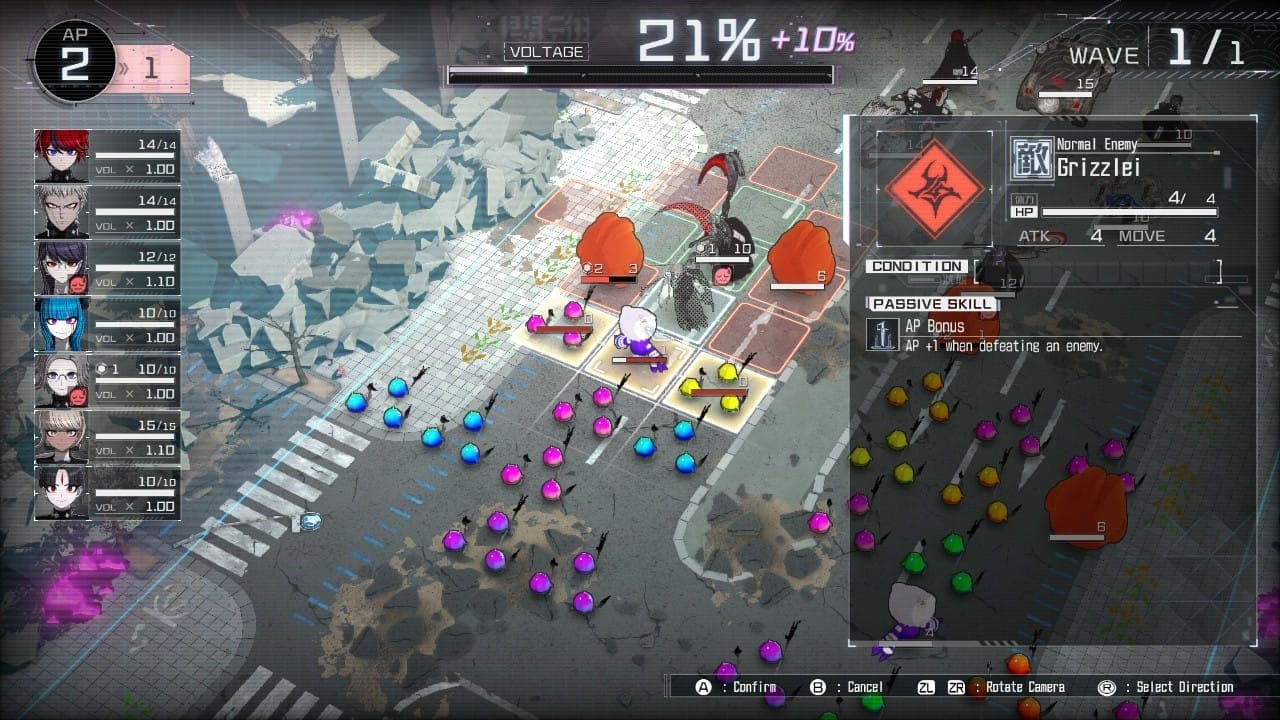
For battles with every party member available, I found myself having a decent chunk of units just sitting there. I initially chalked this up to be a flaw until it finally clicked with me. Having every soldier at your disposal is akin to a trusty toolbox. Some tools work better in certain situations, whereas you are more comfortable using one tool over another. Whether using predetermined units or having everyone available, I focused on my support units to buff my hard hitters as much as possible, additionally supplementing them with agility consumables so they regain their movement after taking an action. This strategy more often than not allowed me to finish most waves within a singular turn, filling me with immense satisfaction seeing all my set up pay off with big damage and constant actions.

As for the consumables, these add an extra wrinkle to fights. Items do not expend an Action Point when utilized, and are refilled after every battle. The small catch is that they are not replenished after each wave, so knowing when to use them is key. Overall, most of these items don’t really detract from combat, but I didn't find a good chunk of them useful either. Being able to hinder enemy movement with fences, or damage Invaders by planting mines is nice, but I found using stronger units more efficient at taking care of foes. In contrast, the medicinal items are extremely useful. Being able to buff character’s attacks or recover from their tired state without using AP was a key reason why I was able to finish most waves within a single turn. There is even one that reduces a character’s HP to one so they can activate their Last Resort to increase Voltage.

Even though I thoroughly enjoyed the battle system, there are still a couple gripes I have with it, and it mostly stems from the mission objectives. There is a severe lack of mission variety beyond killing all the enemies, or taking out the Commander bosses. Any variation on these are few and far between. Additionally, the map design remains a flat terrain with almost no stage gimmicks outside extremely rare exceptions. While a slight bummer, these ultimately ended up as minor nitpicks. To reiterate, the depth in combat comes from how the deployed units play off against the different formations and enemy types presented in each skirmish.
With that being said, the main issue I have in fights are waves within waves. Normally, waves incentivize playing aggressively, as dead units will recover and the Voltage value will carry over. AP will not carry over, so there is no point in conserving them when the waves transition. Yet later fights in the game will have Invaders spawn in at the end of a single turn, with no indication on whether a battle will have this or not. Later fights spam this constantly, and it is frustrating wasting the remaining Action Points to take out the one or two smaller enemies to end a wave, only for more to spawn in the next turn. This is on top of padding each encounter with enemies, making me grow tired of the battles around 40 hours into the adventure.
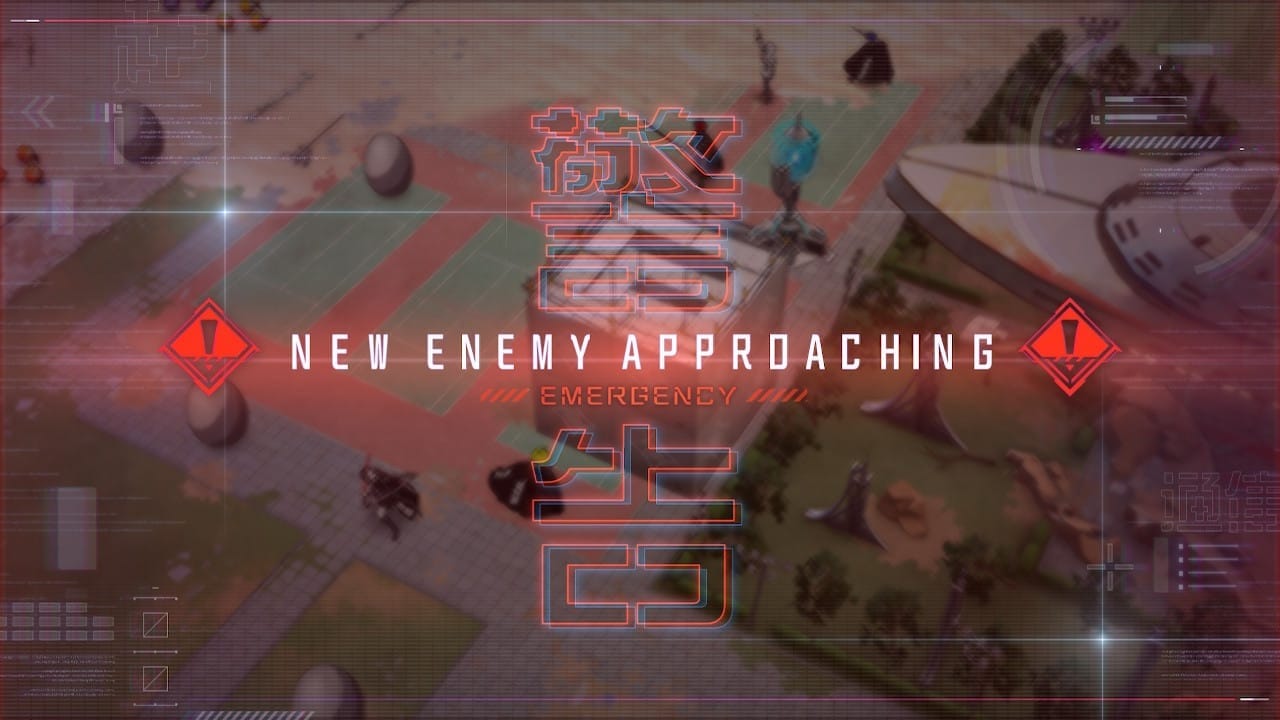
Circling back to the small HP count, the byproduct of this is the lack of a traditional experience point system. After each boss, one of the party members can be selected to perform a killing blow to give them extra buffs in battle. On top of that, each battle nets the player BP that can be used to give party members extra skills and buff old ones. The primary enhancements provided by buffing these skills is extra movement and Voltage gain, further expanding opportunities to regain AP in battle. It is a nice substitute that still advances progression.
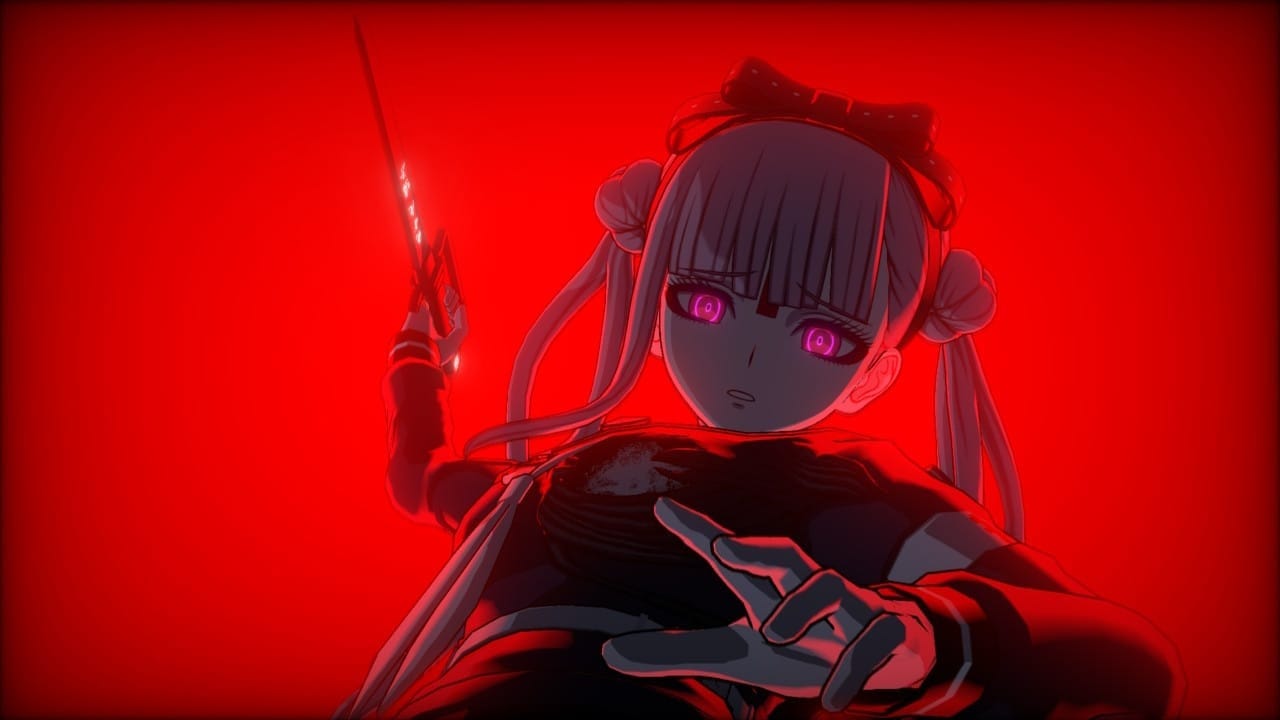
That being said, these higher tier upgrades and items are restricted by field resources and Takumi’s social stats. This is how Hundred Line ties in the signature Free Time mechanics present in Danganronpa games. Takumi can spend time with his comrades to increase one or two social stats associated with that character. Later in the game, the option to give gifts to allies opens up which provides a more efficient method to rank up social stats. Gift giving is overall a more streamlined process in comparison to Kodaka’s previous works. Each item has a description and a type, both of which can be filtered for ease of access. By spending time with characters, new keywords will unlock on top of giving hints to see what kinds of items characters prefer.
Eventually gifts will give affinity points towards characters when giving presents to them, unlocking bond events to flesh out the cast. Unfortunately, what was already a surface level inclusion in Danganronpa games feel even more like an afterthought here. Not only does it take around 30 hours for them to unlock, the actual scenes themselves are extremely lacking. They boil down to a one to two minute scene of the character venting to an offscreen Takumi, with no dialogue from him whatsoever.

Resources for upgrades and gift giving can be acquired during the exploration segments. These have the defense force spending a full day of Free Time venturing past the Undying Flames to scavenge for loot, or reaching designated locations on the map for story missions. Movement is depicted via a board game format. Two cards are given to the player at the start of each turn, with their respective value dictating how many spaces the exploration team can move. Events triggered on each space are dictated by the icon and color of it. The icon indicates which material type that will be acquired, whereas color indicates the risk versus reward stakes in terms of the chance of gaining treasure or taking damage. Battles can occur during exploration as well, keeping the party on their toes during an overall chill game mode.
While there was initial whiplash going from standard strategy RPG battles into a board game, these segments were a nice change of pace from the fights. Moreover, exploration is one of the few times the game allows you to choose which party members to set out with. Since fights are minimal here, each unit has a passive modifier that increases the amount of certain resources that can be acquired. Even if you don’t jive with these sections, Hundred Line offers a Simple Exploration feature, bypassing the need to play through these segments entirely and immediately skipping to the rewards screen. The caveat to this is the character modifiers do not apply to materials gathered this way, which is a nice compromise for the sake of convenience.
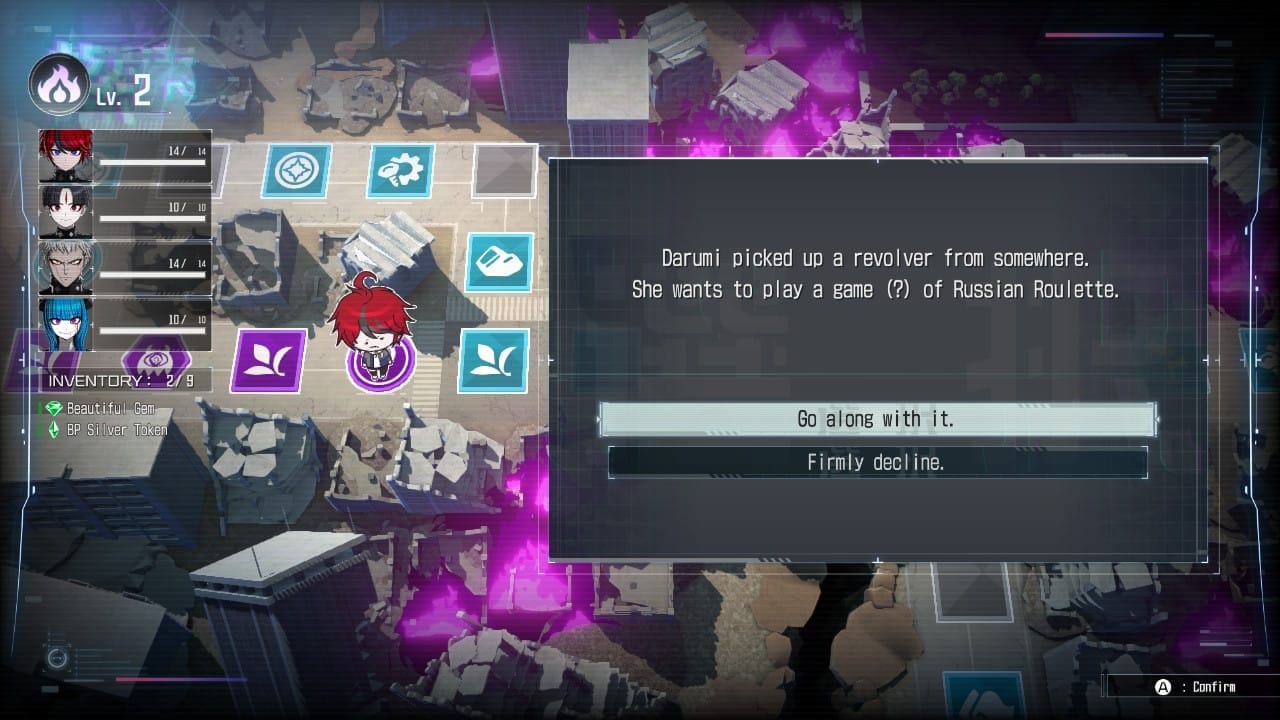
The final, and most prominent gameplay selling point is the branching narrative. It takes a substantial while to get there thanks to the slow burn, but Hundred Line’s story eventually has choices Takumi can make that will lead to one of 100 unique endings. According to the aforementioned development blog, Uchikoshi stated how he wanted each route to be dense enough that they could be considered a true route in of itself.
Non linear narratives are Uchikoshi's bread and butter, but having 100 unique endings is still a lofty ambition. Zero Time Dilemma had over 30 endings, but a good chunk of those were the typical you chose wrong and died type of conclusions. So, did Uchikoshi and his team of nine other writers succeed in making each one feel dense and distinct? Based on the 40 endings I achieved, it is far from perfect, but I would say for the most part, yes.
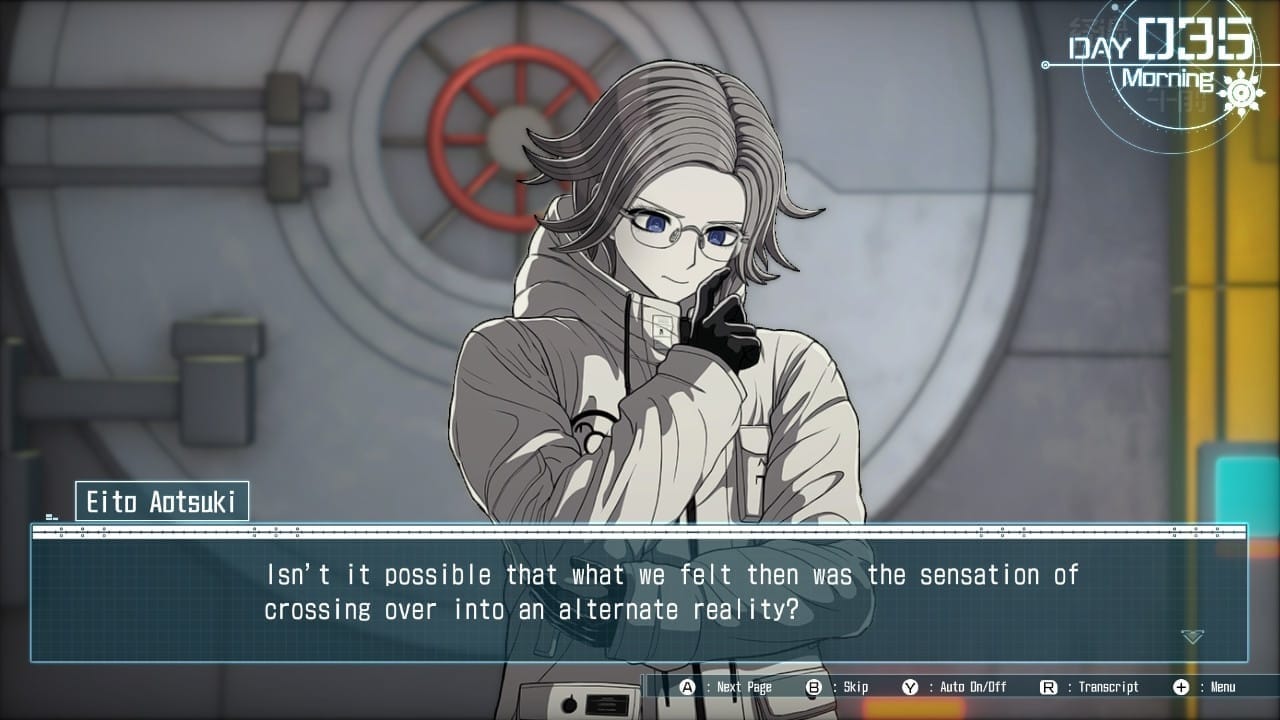
Right away, it is important to note that not all routes are created equal. Both in length and relevance to the overarching story. Some are more lore and world building focused, others center around a singular character, whereas some deviate from the plot entirely. One of the unfortunate byproducts of the 100 day premise is how the later branches feel rushed in the stories they want to tell.
Exposition dumps about world building or new characters are abundant, but we only hear enough about it to get Takumi and the player up to speed. It is the epitome of telling rather than showing. Even in the longer routes, there are still abrupt endings and the occasional, repetitive overlap of events between routes. Still, even if a majority of the routes don't reach the heights of the gripping mysteries present in Zero Escape, or the emotional impact of AI's character routes, they are substantial enough where they come close.
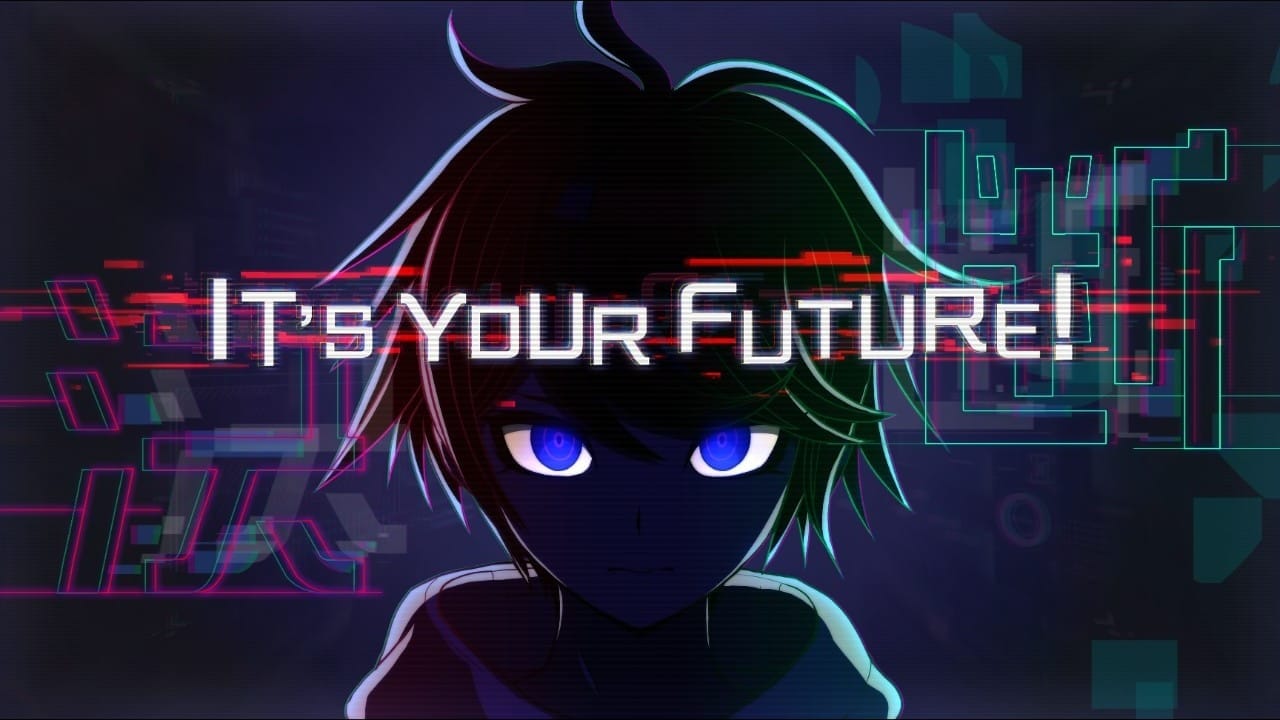
Unlike Uchikoshi’s previous titles, Hundred Line fortunately does not require the player to unlock all 100 endings in order for the true end to open up. The trade off is that the game does not outright say whether the player is traveling down the tracks of the true route until an ending is reached. I personally adored this lack of direction for multiple reasons. The point this game hammers home is how Takumi’s choices affect the future he fights for; the desire of achieving the best outcome for everyone. Paying attention to the core conceit of the narrative is vital in determining what you personally think the best outcome is, and how to get there. Essentially, it gamifies reading comprehension, and personal feelings on its contentious subject matter. Still, for those who want to barrel down the main path, there are enough context clues to know if you're on the right track.
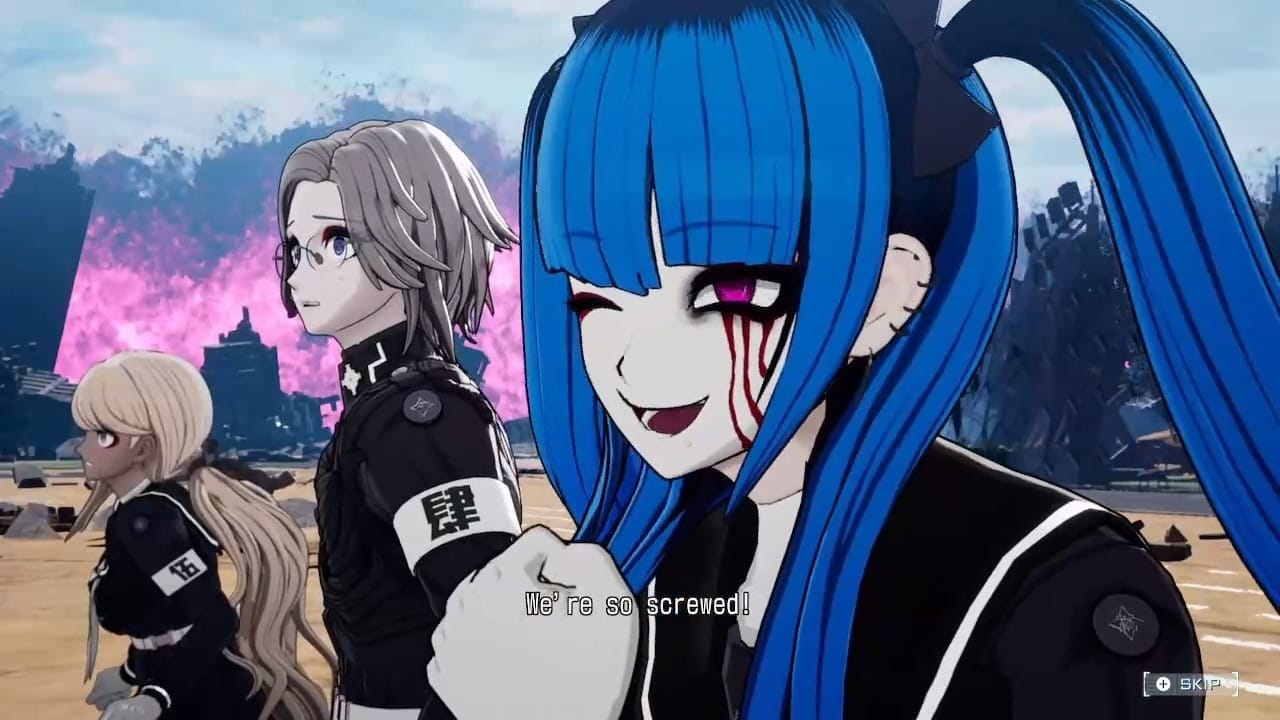
What further elevates the nonlinear narrative, is how the core premise and subject matter serves as a thematic umbrella to house each branching storyline. Authority figures thrusting children into a bloody conflict opens the door for Takumi and the cast to view various positions and perspectives on the war. The line of right versus wrong is blurred upon each new revelation, which phenomenally furthers the tension with how each dilemma is framed. Every crossroad is constructed in a way where the party of kids could easily respond to the multiple decisions the game provides. No matter what Takumi decides, he is bound to upset or unintentionally harm someone. Sure, there is a flowchart that allows you to return to the initial choice if they want to change the outcome, especially if you’re aiming to unlock all the endings, but what matters is the emotional repercussions of Takumi’s choice. How it affects the trajectory of his character development.
This nuance in presenting different perspectives and consequences means most of the routes are satisfying even when deviating from the primary path. Each one has their own set of reveals and strong character moments that gives credence to Uchikoshi’s objective on making every branch feel rewarding as their own self-contained story, while also giving context to events in the main scenario.
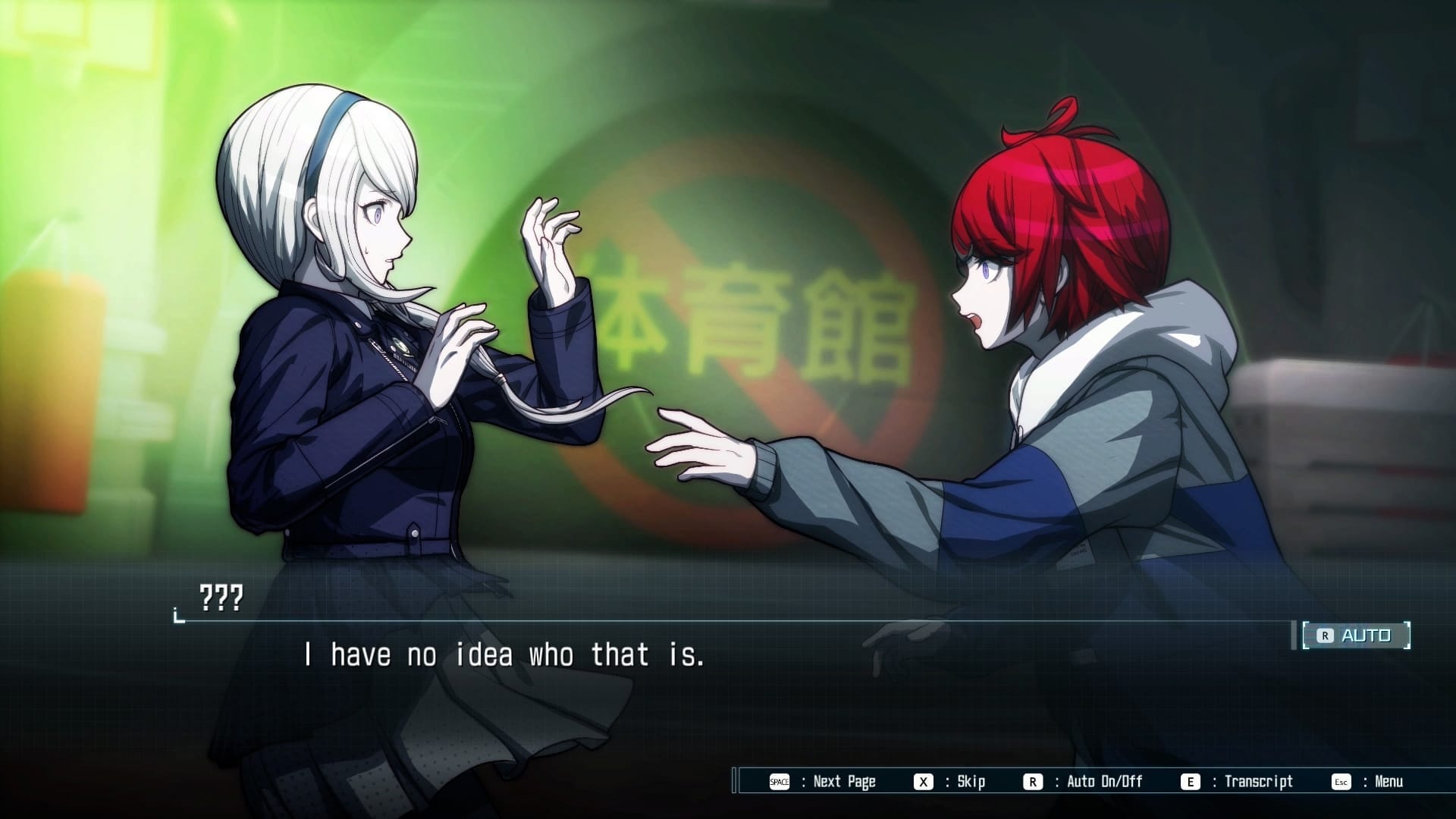
Rewarding is an apt way to describe it, in spite of a few underdeveloped elements. Even though there exists a true end, it is all about finding an ending that you feel is the most rewarding. Seeking an ending that is true to you by putting yourself in the shoes of these characters, or remain an overseeing entity through the screen when deciding their destiny. Whether the outcome has them living with satisfaction or regret. Whether you think they deserve a happy ending or not. I adore the true ending, and believe it is the most narratively satisfying conclusion that phenomenally encapsulates what Uchikoshi and Kodaka want to say about the simultaneous destructiveness and empathy of humanity.
Yet admittedly, the idealistic part of me preferred other endings with how those paths conclude the war; even if my preference was propped up by foolish optimism. And that is such an amazing achievement of storytelling provided by this take of Uchikoshi’s staple story framework. The interconnectedness between player and a story that rewards more depending on how much you put into it, the choices you make. It gives a hefty weight to each decision knowing it can lead to wildly different storylines when finding a conclusion that resonates most to you.
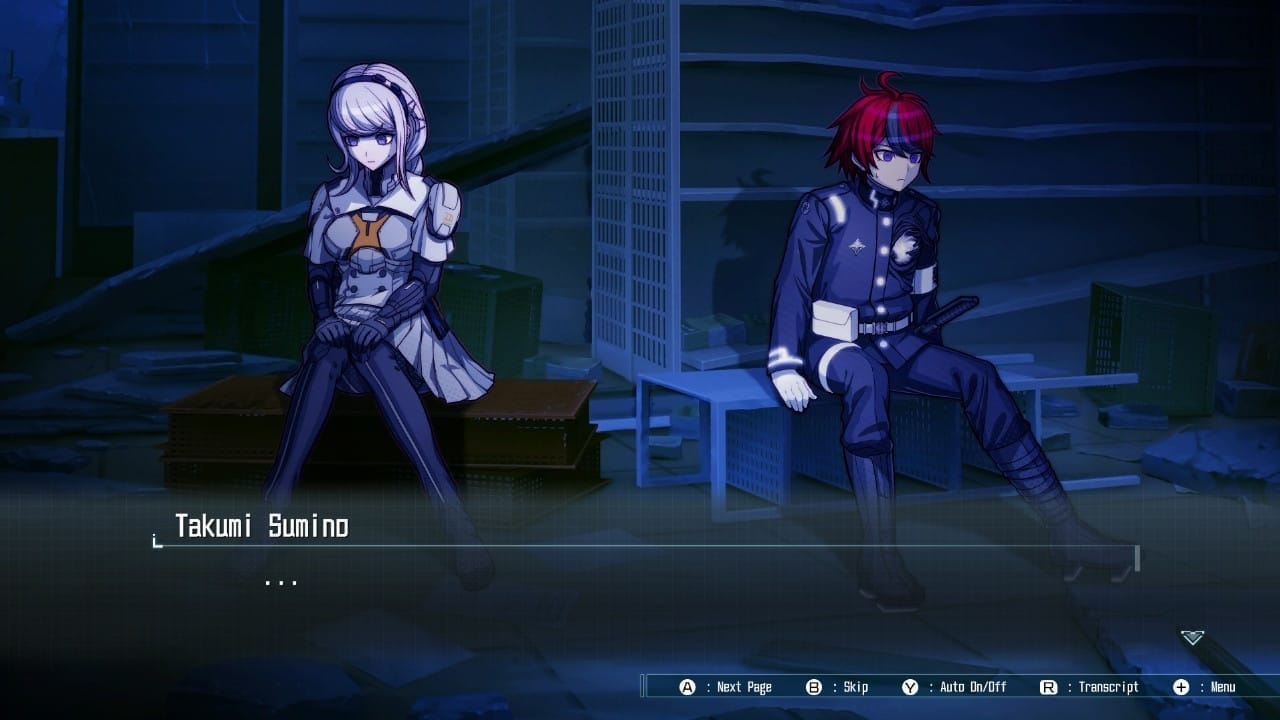
The remarkable story doesn't just stop at the gameplay and narrative either. Both the visuals and audio are layered in atmosphere and symbolism to elevate the world that has been crafted. Before diving into that, let's talk about technical housekeeping first. My 80 hour adventure was spent playing on the Switch, and it is an adequate version with some minor drawbacks. Primarily the lack of anti-aliasing causing the outlines of characters standing in the background to look like a pixelated mess. Combat mostly maintains a stable framerate, but there is occasional choppiness whenever the map is flooded with foes. And while not bad, some of the load times can go on a tad longer than I would like. Other than that, I had no other issues with the Switch port.

Once again, character designer Rui Komatsuzaki and composer Masafumi Takada return for another collaboration with Kodaka. Ever since the reveal, I have been underwhelmed by the character designs. Even after almost a hundred hours familiarizing myself with the ensemble, I still find their designs to be a mixed bag. They either gravitate towards being unmemorable and basic, or having aspects that are overdesigned. Some of them eventually grew on me, such as Darumi having oversized safety pin accessories for no reason, but others such as Takumi’s hair has the same energy as mixing the red and blue flavors of a slushie together.

On the bright side, everything else in Hundred Line’s visual identity looks incredibly sleek. The campus is a mishmash of a normal school mixed with a militarized, cyberpunk flare. The same goes for the menus and UI, giving off the vibe that you are scrolling through classified documents in a sci-fi world. The imagery in this game serves as unsubtle metaphors relating to the overarching conflict. These students have blood based powers called Hemoanima, which essentially allows them to wield impressive weapons. Activating these powers requires them to stab their heart with a knife, the blood surrounding them as they power up and gain their combat uniforms. These are excellent fits that accentuates their stab wounds with a white flame emitting from the chest cavity. Kids quite literally killing their own innocence, forced to fight in a conflict paved in bloodshed.

With Masafumi Takada at the helm, it is not a surprise that Hundred Line’s soundtrack is fantastic. Admittedly there are some tunes that feel nearly identical to previous Danganronpa tracks, but by and large they set the tone incredibly well. I just wish there was more of it, as hearing the same few battle themes or Free Time music got mildly grating after a while. Regarding the English voice acting, it unfortunately isn’t great. Don’t get me wrong, it’s not bad at all, and there are some solid performances with occasional excellent line reads. It just consistently feels a tad wooden. Also, the lack of having fully voiced lines outside a handful of scenes meant less time for me to familiarize myself with the voices.
The Hundred Line -Last Defense Academy-
Great
If I were to describe The Hundred Line -Last Defense Academy- with one phrase, it would be greater than the sum of its 100 parts. Despite the hurdles in its character writing and monotonous first 30 hours, this collaboration feels like a culmination of Uchikoshi and Kodaka's driving philosophies. Hundred Line's joyful and cruel execution of its themes is the linchpin of its quality. The strategy RPG battles are compelling in both gameplay and story. Uchikoshi’s fresh and risky take on his branching narrative framework brings to life world building and heartfelt character moments. But it was Kodaka’s contributions to the main scenario that most surprised me as someone mixed on most of his games. If Danganronpa v3 was an artist's celebration and critique on artistic expression, then Hundred Line is a human's celebration and critique on humanity. The capacity of people to love and hate. By its final moments I was reduced to a sobbing mess, and that is all the confirmation I need to know that Too Kyo's six year ambitions have paid off.
Pros
- Engaging and approachable strategy RPG battles
- Strong showing from veteran art and audio team
- Branching storyline adds layers to story
- Takumi is an emotionally compelling lead
- Thematically resonant and relevant story with a powerful message....
Cons
- ...that unfortunately takes 30 hours to become interesting
- Lackluster, and mostly poorly written cast
- 100 endings means some feel a tad underdeveloped
This review is based on an early Nintendo Switch copy provided by the publisher. The Hundred Line -Last Defense Academy- comes out on April 24, 2025.
